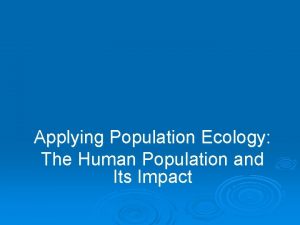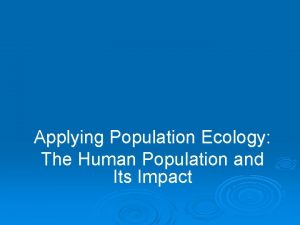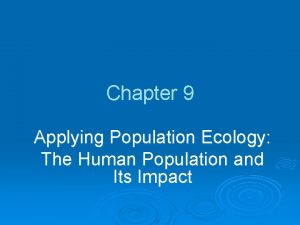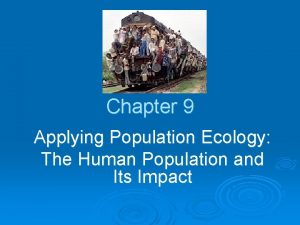Population Health Applying Health IT to Improve Population



















- Slides: 19

Population Health Applying Health IT to Improve Population Health at the Community Level Lecture b This material (Comp 21 Unit 2) was developed by Johns Hopkins University, funded by the Department of Health and Human Services, Office of the National Coordinator for Health Information Technology under Award Number 90 WT 0005. This work is licensed under the Creative Commons Attribution-Non. Commercial-Share. Alike 4. 0 International License. To view a copy of this license, visit http: //creativecommons. org/licenses/by-nc-sa/4. 0/.

Applying Health IT to Improve Population Health at the Community Level Learning Objective — Lecture b • Compare and contrast the traditional public health perspectives with the population health perspective. • Summarize the potential for health information technology to improve the health of populations at the community/geographic level. 2

Current Focus of Most Public Health IT Systems • Births/deaths — vital records. • Tracking/surveillance of reportable conditions (e. g. , H 1 N 1, STI, HIV, TB, lead poisoning). • Immunization tracking. • Cancer registries. • Congenital disease tracking/newborn screening. 3

HIT Support for Population Health at the Community/Geographic Level • • Needs assessment/service prioritization. Surveillance/case finding. Linkage between public health and medical services. Linkage of medical and social services. Consumer education/outreach. Geographic level interventions (GIS). Linkage of community outcomes to providers “pay for performance” (P 4 P) — e. g. , as part of “triple aim. ” • Adding to evidence base — the “learning community health system. ” • Evaluation/outcome assessment. 4

Population Health at the Community Level: Case Study 1 • Case Study 1: Understanding Community-Level Factors Related to Obesity among Veterans. – Builds on the largest EHR database in the U. S. , with more than 30 million patients. – Potentially the largest historical database in the U. S. , with historical BMI information and clinical risk factors. – Based on residence of veteran project links in public health, socioeconomic, and community-level data relevant to the obesity epidemic at the population level. 5

Population-Based Analytic/ Predictive Model for Obesity Electronic BMIs derived from EHRs of national care system (obesity levels based on 29, 000 BMIs captured in one day in EHRs). 2. 11 Figure: Johns Hopkins Center for Population Health IT (CPHIT). Map showing 2014 poverty rates by county. 2. 12 Figure: U. S. Department of Commerce Economic and Statistics Administration, U. S. Census Bureau. 6

Geographic-Level Population Decision Support — Obesity within the VA Health Care System 2. 13 Figure: Image compilation from U. S. Department of Veterans Affairs (VA), Veterans Health Administration (VHA), Office of Analytics and Business Intelligence (OABI). 7

Population Health at the Community Level: Case Study 2 • Case Study 2: Using Health Exchange and Geo Data to Develop Community-Level Health Metrics in Baltimore, Maryland. – The CRISP HIE in Maryland is one of few in the U. S. with 100% participation of all hospitals. – Maryland now has “all payer” global budget that rewards hospitals for shifting focus to the community. – Collaborative team is linking medical, geographic, and social data to address various health issues at the community level. – Projects include hot-spotting outlier hospitalizations, falls in the elderly, and opioid addiction. 8

Conceptual Model for the Maryland Population Health Information Network (M-PHIN) 2. 14 Chart: Jonathan Weiner and Center for Teaching and Learning, Bloomberg School of Public Health, Johns Hopkins University. (2016). 9

Hot-Spotting Baltimore Hospitalizations Using HIE Data 2. 15 Figure: Maryland Department of Health and Mental Hygiene for U. S. Department of Health and Human Services, Centers for Medicare and Medicaid Services State Innovation Models (SIM) Initiative. 10

Population-Based Predictive Analytic/Intervention of Elders’ Falls Linking EHRs and Social Data Rates of falls by neighborhood, derived from real-time health information exchange data in Baltimore City (draft results). 2. 16 Figure: Adapted by Kharrazi et al. (2016). Johns Hopkins Center for Population Health IT (CPHIT). GIS map of housing types in Baltimore by census tract. 2. 17 Figure: City of Baltimore Zoning Districts. 11

Advances in Population Health Analytics • Ways to integrate disparate “numerators” and “denominators” to define true populations. • Ways to identify those at risk, both at the community and patient-panel levels. • Advanced tools for extracting unstructured data from many sources using text mining (NLP). • Real-time signals and dynamic modeling. • Models and tools to help medical care systems move away from FFS toward “population value” perspectives. 12

Applying Health IT to Improve Population Health at the Community Level Summary — Lecture b — 1 • The domain of population health informatics and population health information technology, HIT, is a composite of various, sometimes independent, disciplines. • Examples of HIT-supported activities that can be used for population health improvement at the community or geographic level. 13

Applying Health IT to Improve Population Health at the Community Level Summary — Lecture b — 2 • Case studies, including: – Johns Hopkins CPHIT’s study utilizing Veteran’s Affairs electronic health record database and obesity – A collaborative effort in the Baltimore and Maryland communities that focuses on community health for the entire state and region. This study uses health exchange and geo data. 14

Applying Health IT to Improve Population Health at the Community Level Unit Summary • Health HIT applied to the improvement of population health at the community level. • The relevance of CPHIT’s Ecological Framework for Population Health to the concept of population health at the community level. • Other types of factors, such as social factors and nonmedical factors and how they impact health and wellness. • Comparisons of traditional public health perspectives with the population health perspective. • The potential for health information technology to improve the health of populations at the community and geographic levels. 15

Applying Health IT to Improve Population Health at the Community Level References — Lecture b — 1 References Friedman, D. J. , & Parrish, R. G. II. (2010, August). The population health record: Concepts, definition, design, and implementation. Journal of the American Medical Informatics Association, 1(7), 359– 66. http: //www. ncbi. nlm. nih. gov/pubmed/20595299 Hunt, J. S. , Gibson, R. F. , Whittington, J. , Powell, K. , Wozney, B. , & Knudson, S. (2015). Guide for developing an information technology investment road map for population h ealth management. . Population Health Management, 18(3), 159– 171. Kharrazi H. , & Weiner, J. P. (2014, October 30). IT-enabled community health interventions: Challenges, opportunities, and future directions. e. GEMs, 2(3), 1117. This overview article links to 14 other articles in this special edition of this online journal. http: //www. ncbi. nlm. nih. gov/pubmed/25848627 Kindig, D. A. (2007, March). Understanding population health terminology. Milbank Quarterly, 85(1), 139– 161. http: //www. ncbi. nlm. nih. gov/pubmed/17319809 16

Applying Health IT to Improve Population Health at the Community Level References — Lecture b — 2 Charts, Tables, Figures 2. 11 Figure: Johns Hopkins Center for Population Health IT (CPHIT). [Hot-spot U. S. map of reported BMI categorizations]. 2. 12 Figure: U. S. Department of Commerce Economic and Statistics Administration, U. S. Census Bureau (2015). Poverty Rates of the Total Population by County: 2014. Retrieved April 19, 2016, from https: //www. census. gov/did/www/saipe/data/highlights/files/2014/F 3_MP_14. pdf 2. 13 Figure: U. S. Department of Veterans Affairs, Veterans Health Administration, Office of Informatics and Analytics and Business Intelligence. 2. 14 Chart: Jonathan Weiner and Center for Teaching and Learning, Bloomberg School of Public Health, Johns Hopkins University. (2016). [Conceptual model for M-PHIN]. 2. 15 Figure: Maryland Department of Health and Mental Hygiene for U. S. Department of Health and Human Services, Centers for Medicare and Medicaid Services State Innovation Models (SIM) Initiative. 2. 16 Figure: Kharrazi et al. (2016). Johns Hopkins Center for Population Health IT (CPHIT). [Map of Baltimore City neighborhoods showing health information exchange data for rates of fall by the elderly]. 17

Applying Health IT to Improve Population Health at the Community Level References — Lecture b — 3 Charts, Tables, Figures 2. 17 Figure: Department of Planning, City of Baltimore (2010). Zoning Districts. Retrieved April 19, 2016, from http: //archive. baltimorecity. gov/Government/Agencies. Departments/Planning/Master. Pl ans. Maps. Publications/Maps. aspx 18

Population Health Applying Health IT to Improve Population Health at the Community Level — Lecture b This material (Comp 21 Unit 2) was developed by Johns Hopkins University, funded by the Department of Health and Human Services, Office of the National Coordinator for Health Information Technology under Award Number 90 WT 0005. 19
 Protect, promote, and improve the health of all people
Protect, promote, and improve the health of all people Chapter 4 population ecology worksheet answer key
Chapter 4 population ecology worksheet answer key Section 1 population dynamics answer key
Section 1 population dynamics answer key Population ecology section 1 population dynamics
Population ecology section 1 population dynamics Chapter 4 section 1 population dynamics study guide
Chapter 4 section 1 population dynamics study guide Andalusian chicken incomplete dominance
Andalusian chicken incomplete dominance Approaches to literary criticism
Approaches to literary criticism Applying mendel's principles
Applying mendel's principles Applying angle relationships homework 2
Applying angle relationships homework 2 Example of ruler postulate
Example of ruler postulate Applying critical approaches to literary analysis quiz
Applying critical approaches to literary analysis quiz Food mixer
Food mixer Light cured gels are not:
Light cured gels are not: Gauss law
Gauss law 11.2 applying mendel's principles
11.2 applying mendel's principles Applying the pythagorean theorem homework 3
Applying the pythagorean theorem homework 3 Applying properties of similar figures
Applying properties of similar figures Chapter 33 applying paints and enamels
Chapter 33 applying paints and enamels Chapter 3 applying learning theories to healthcare practice
Chapter 3 applying learning theories to healthcare practice Applying agile approach in erp implementation
Applying agile approach in erp implementation




































